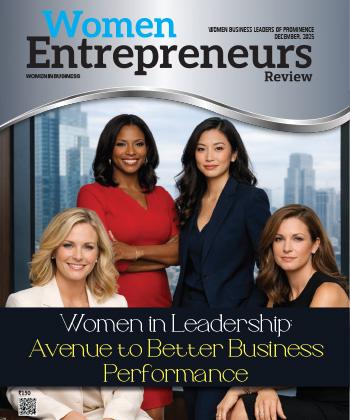
Driving Innovation with Strategic Decision-Making & Effective Mentorship
By: Kunda Jadhav, Chief Administration Officer, Scotiabank
Kunda is an accomplished executive with nearly 30 years in leadership roles across major US and UK banks, including Barclays and JP Morgan. A Six Sigma Black Belt, she excels in operational efficiency and strategic planning, driving productivity and governance. A mentor and diversity advocate, Kunda inspires growth and innovation.
In a conversation with Women Entrepreneurs Review Magazine, Kunda shares insights into the current market dynamics highlighting how evolving decision-making processes can enhance women's inclusion and empowerment in organizations. She also talks about effective decision-making and mentorship fostering supportive, equitable workplaces, balancing agility with long-term DEI goals and offering valuable lessons for industry leaders.
Considering the current market dynamics, how do you see decision-making processes evolving to foster greater inclusion and empowerment of women within organisations?
In today’s world of a divergent economic landscape, and with the backdrop of confluence of various trends, and disruptive forces reshaping the foundational architecture of various Industries, it is crucial for Organisations to be Agile and for their leaders to adapt quickly to the changing scenarios. The leaders today, even more than before, are required to demonstrate conviction and agility to thrive. The leaders are expected to come up with creative solutions, as they navigate the changing contours while leading their Company, Staff, Customers and Communities they support.
Research has shown that Organisations with greater gender and ethnic diversity are not just more equitable but also more likely to outperform their competitors, financially. Women are now scaling the ranks of corporate hierarchies, leveraging their talents and perspectives to drive meaningful change at the highest echelons of leadership.
It is the transformative power of women in leadership, and the profound impact they have on organisational culture, performance, and success, that is widely accepted.
The decision-making by the leaders of the Organisations is of key essence, which directly has consequences on the Organisation’s profitability and purpose. Making decisions is subjective as it entails a blend of logical thinking, applying continuous learning, emotional intellect , and a commitment to ethical values; Hence the leaders often find themselves on the crossroads having to navigate between what is right versus wrong, and these challenges can be handled better by adopting a transparent model of functioning, and by consistently keeping a watch on the moral implications of their choices, and by ensuring the decisions indeed align with their organization's values and societal expectations.
In your experience, how has effective decision-making empowered women within organizations?
Across various industries, most entrepreneurs and Organisational executives still tend to be men, but more and more women are becoming business leaders and decision makers.In order todevelop a diverse workforce, businesses are establishing inclusive practices to attract, nurture and retain talent. In recent decades, we have witnessed a paradigm shift in gender dynamics within leadership roles. More women are taking on executive positions. Today, women are spearheading multinational corporations, leading successful startups, making impactful policy decisions, and influencing various domains traditionally dominated by men. Women are empowered to drive key business strategies and they are thriving at this as they bring unique perspectives, empathy, and collaborative approaches, challenging the conventional practices and driving innovation.
From your perspective, how can strategic decisions in banking administration foster a more inclusive environment for women, both internally and within customer interactions?
Inclusivity in workspace can also foster innovation and creativity within the workplace. When employees come from diverse backgrounds, they bring unique perspectives and experiences that can lead to innovative solutions to business problems. Organisations can benefit from this by tapping into the full potential of their employees and driving growth and success for the business.
Inclusivity in workspace is essential for Organisations to succeed in today’s global economy. By creating a diverse and inclusive work environment that provides equal opportunities and support for all employees, workplaces can attract and retain top talent, foster innovation and creativity, and ultimately drive growth and profitability. Therefore, Organisations have been now prioritizing to create inclusivity in workspace culture that values and respects all employees, including women, internally, as well as with the Customers, and for Communities, at large.
In your opinion, how does a robust decision-making process contribute to creating a more supportive and equitable workplace environment for women, and what role does mentorship play in enhancing these skills?
Organisations are largely striving to adopt a gender-inclusive culture that values and respects all individuals regardless of their gender identity, where people can express themselves freely and without fear of discrimination. They are prioritizing self-awareness, education and knowledge about gender diversity and taking an intersectional approach to understand how different identities and experiences impact gender. Ultimately, a gender-inclusive culture helps to break down gender-based power structures that lead to marginalization and exclusionary practices.
When organisations create an inclusive work environment, they are better positioned to recruit and retain a diverse pool of talented employees, including women. By offering equal opportunities and providing a supportive work environment, organisations are creating a workplace culture that is attractive to top talent. This can result in increased employee engagement, job satisfaction, and productivity, which can ultimately lead to better business outcomes.
Inclusivity in workspace, especially for women, is critical as it goes beyond improving workplace culture and employee morale. Inclusivity can help companies to attract and retain top talent, drive innovation and creativity, and improve business outcomes. One of the key initiatives to retain and nurture women workforce is providing Mentorship, which helps in increasing the awareness of diversity concerns, and evade attrition.
From your perspective, what are the critical success factors for integrating gender perspectives into strategic Business decisions, and how can these insights be effectively communicated across the organization?
The success factors for integrating the gender perspectives into Strategic business decisions, rly depend on how serious the organisation is in making the real impact in this regard. The efficiency, efficacy, relevance and coherence of the Diversity, Equity & Inclusion objectives have to be evaluated at all stages. It cannot be just a ‘Tick the Box’ exercise, and requires mainstreaming of these initiatives, i.e. setting up policies and procedures, and bringing greater accountability and ownership for all the stakeholders. It is also pertinent to communicate these policies and initiatives in a transparent manner across the organisation, and the progress report showcased to the employees in the Townhalls etc.,
According to you how can leaders balance the need for agile decision-making with the long-term goals of fostering a diverse, equitable and inclusive workplace, and what lessons can other industry leaders learn from this approach?
The Diversity, Equity and Inclusion initiatives have the potential to greatly enhance the development of the people within the organisation and drive the overall business goals for the organisation, The successful absorption of these initiatives is essential for a collective purpose and vision of the organizational goals to fructify, and therefore imperative that there is an ongoing support of the entire leadership. The leaders need to make balanced and agile decisions by:
a) being inclusive, i.e. by seeking input from others.
b) By considering long-term consequences, as well as
c) By continuously learning from their decisions and mistakes.
Each of the decision-making processes results in final choices which might end in a certain procedure that may or may not be taken to solve a problem or to settle things for the organization. Yet the leaders should strive to make the right decisions and must believe in the benefits of a diverse, equitable, and inclusive workplace brings.
Most Viewed
- 1 Women's Health Startup HerMD Closing Doors Amid Industry Challenges
- 2 5 Famous Women in Indian Armed Forces
- 3 Saudi Women No longer Require Male Permission for Clothing Choices, says Prince MbS
- 4 Kolkata Medtech Startup Innovodigm Raises Rs 5.5 Crore Seed Funding Led by IAN Group
- 5 Yamunanagar's Kashish Kalra Honoured after Securing 111th Rank in UPSC Civil Services Exam
- 6 Madurai Appoints Its First Woman Corporation Head
- 7 IAS Vijayalakshmi Bidari Appointed as the new Nagpur Divisional Commissioner
- 8 American Entrepreneur Lucy Guo Overtakes T Swift to become Youngest Female Billionaire
- 9 ICC Women's World Cup 2025 Trophy Showcased at Indore's Holkar Stadium
- 10 Aparna Saxena's Beauty Venture AntiNorm Launches in India
- 11 Vidya Nataraj Co-Founded BlueStone Jewellery & Lifestyle files IPO
- 12 5 Women Freedom Fighters of India
- 13 Dr. G Krishnapriya appointed as CEO for Trichy
- 14 M3M & Sirona Partner to Introduce Menstrual Hygiene Vending Machines in 15 Locations
- 15 Punjab Govt launches SHE Cohort 3.0 Supporting Tech-led Women Startups
- 16 Indian origin Lawyer, Sweena Pannu appointed as the US New Superior Court Judge
- 17 The Aurora Tech Award recognizes 4 Indian Women-led Startups
- 18 Kerala's Republic Day parade featured an all-female tableau
- 19 Manisha Kabbur Becomes Karnataka's First Woman International Karate Coach
- 20 Director K. S. Ravikumar's Daughter Maalica Ravikumar Launches Life Coaching Company 'Evergrowth Academy' for Women
- 21 Leezu's Raises Pre-Seed Funding to Accelerate Growth in Sexual Wellness Industry
- 22 Sattu: Super-easy summer drink for PCOS gut healing
- 23 Swathi Nelabhatla creates Sitha App, India's First Women-Exclusive Gig Platform
- 24 7 Timeless Female Kathak Dancers & their Iconic Legacies
- 25 Meet 7 Iconic Women Architects of Modern India & their Most Impactful Work
- 26 This Woman-led Insuretech Startup is Helping Bridge the Education Financing Gap in India
- 27 Women Leaders Share Lessons Learnt from India Women's WC Win
- 28 5 Enterprising Women Founders Powering Singapore's Tech & Innovation Landscape
- 29 4 Women. 4 Stories. One Vision for Smarter, Stronger Healthcare
- 30 Global Gender Gap Narrows to 68.8%, But Full Equality 123 Years Away: WEF Report 2025
- 31 Changemakers: 7 Women Entrepreneurs Taking the Make in India Movement Forward
- 32 Meet Lucy Guo, The Youngest Self-Made Female Billionaire Disrupting Tech
- 33 How Women are Driving India's Festive Online Shopping Surge






